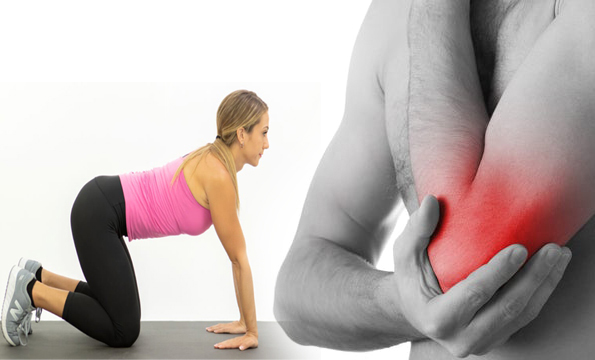 Tennis Elbow is a condition characterized by pain with mild swelling of the bony prominence on the outer side of the elbow. A similar process on the inner side of the elbow is termed Golfer’s elbow. Although this condition is commonly related to injuries during these sports, it can occur in professionals who use their hands with repetitive movements such as mechanics, painters, computer users etc.
Tennis Elbow is a condition characterized by pain with mild swelling of the bony prominence on the outer side of the elbow. A similar process on the inner side of the elbow is termed Golfer’s elbow. Although this condition is commonly related to injuries during these sports, it can occur in professionals who use their hands with repetitive movements such as mechanics, painters, computer users etc.
Generally the pain aggravates on bending the wrist against resistance and relieved by rest; usually lasts 6-8 weeks; sometimes may go on with persistent pain for a few months. The cause is inflammation at the site of attachment of the muscle to the bone induced by repeated tears during repeative movements.
What is the Complementary Management?
Pain relief, when the pain is acute rest the arm by stopping all movements that cause pain. Apply ice pack to the outside of the elbow. Use of supporting wrist splints may help.
After the pain is relieved, physiotherapy and necessary changes in work site, and job situation etc., would be very useful.
Yoga therapy can be of great help at this stage. The principle is to provide very deep rest with conscious focused awareness on the point of pain. This unfolds the local healing potential in the cells of the region.
Although the root cause of the pain appears to be local inflammation due to overstretching by repetitive movements, yoga makes us understand that this is only the tip of the ice burg. The inflammation and pain are the peripheral manifestations of the deeper underlying prana imbalance which has picked up this tendon to manifest the imbalance. Hence it is important that we combine deeper level corrections through pranayama and meditation along with local physical movements to promote healing in cases of long standing pain of tennis elbow. It is also important to recognize that mental tension which is an inseparable component of this type of professionals is the root cause of the underlying prana imbalance. Hence cyclic meditation and notional correction to understand how to manage stress in the karma yoga way is also very important. The physical postures work by providing mild stretch to the part followed by deep rest. This promotes better blood flow and hastens healing. Then comes the component of strengthening the muscles around the elbow. For this one needs to do second level of asanas that encourage weight bearing on the hands and elbows. Hence the list of practices of IAYT for tennis elbow are
Step I – hands stretch breathing. Hands in and out breathing, ankle stretch breathing, sasankasana breathing, Ardhakati Cakrasana, Padahastasana, Trikonasana, Salabhasana, Vakrasana, Ustrasana, Paschimottanasana and Supta vajrasana. After 6 weeks when the pain is not felt, move on to asanas of Step II – which involves weight bearing on the hands such as Tiger breathing, Rabbit breathing, Dog breathing, Prasarita Padahastasana, Parivritta trikonasana, Bhujangasana, Dhanurasana, Viparitakarani, Sarvangasana,
Matsyasana, halasana.
In both steps it is important to end with Shavasana (DRT) for 10 minutes, Pranayama for 20 minutes and cyclic meditation for 30 minutes.
Laghu Vajrasana
Laghu means little or small, easy. Vajra means a thunderbolt, the weapon of Indra, the king of gods.Technique
- Kneel on the floor with the knees and feet together. Rest the palms on the sides of the waist.
- Exhale, arch the spine back and at the same time tighten the muscles of the thighs.
- Push the hips forward and keep bending the spine back until the crown of the head rests on the feet. It requires regular long term practice to achieve the necessary spinal elasticity. The weight of the body is borne only on the knees.
- When the above position is achieved, remove the hands from the waist, stretch the arms straight from the shoulders and grip each knee with respective hand.
- As to the spine is stretched the abdomen is pressed, breathing becomes fast and laboured. Try to observe this and make it rhythemic and fast and then try to hold the pose for 10 to 15 seconds while breathing normally.
Disclaimer
Yoga Ayurveda Therapy is Complementary Medicine and doesn't alternates any conventional treatment.
Yoga-Ayurveda Therapy needs physical assistance which may need physical touch. You can ask teacher or therapist not to give physical touch or assistance and based on whatever you choose, our teacher or therapist will follow the instructions. Any point you want to change the preference, then please inform teacher or therapist and management in writing. You will take responsibility of your decision and will not hold Union Yoga Ayurveda responsible for any kind of damage.
All kind of Yoga Ayurveda teaching and therapy can cause certain injuries and you are accepting those injuries. Signing up for the therapy or yoga courses means that you are aware of the probable injuries.
Union Yoga Ayurveda (Union Centre Pte Ltd) and its staff are not liable or responsible for any injuries caused during the session which are visible or not visible, physical or hormonal or mental. You as client take full responsibility of your own decision and will not claim any kind of compensation in terms of money or any resources for the damage caused because of due process.
Next Post

